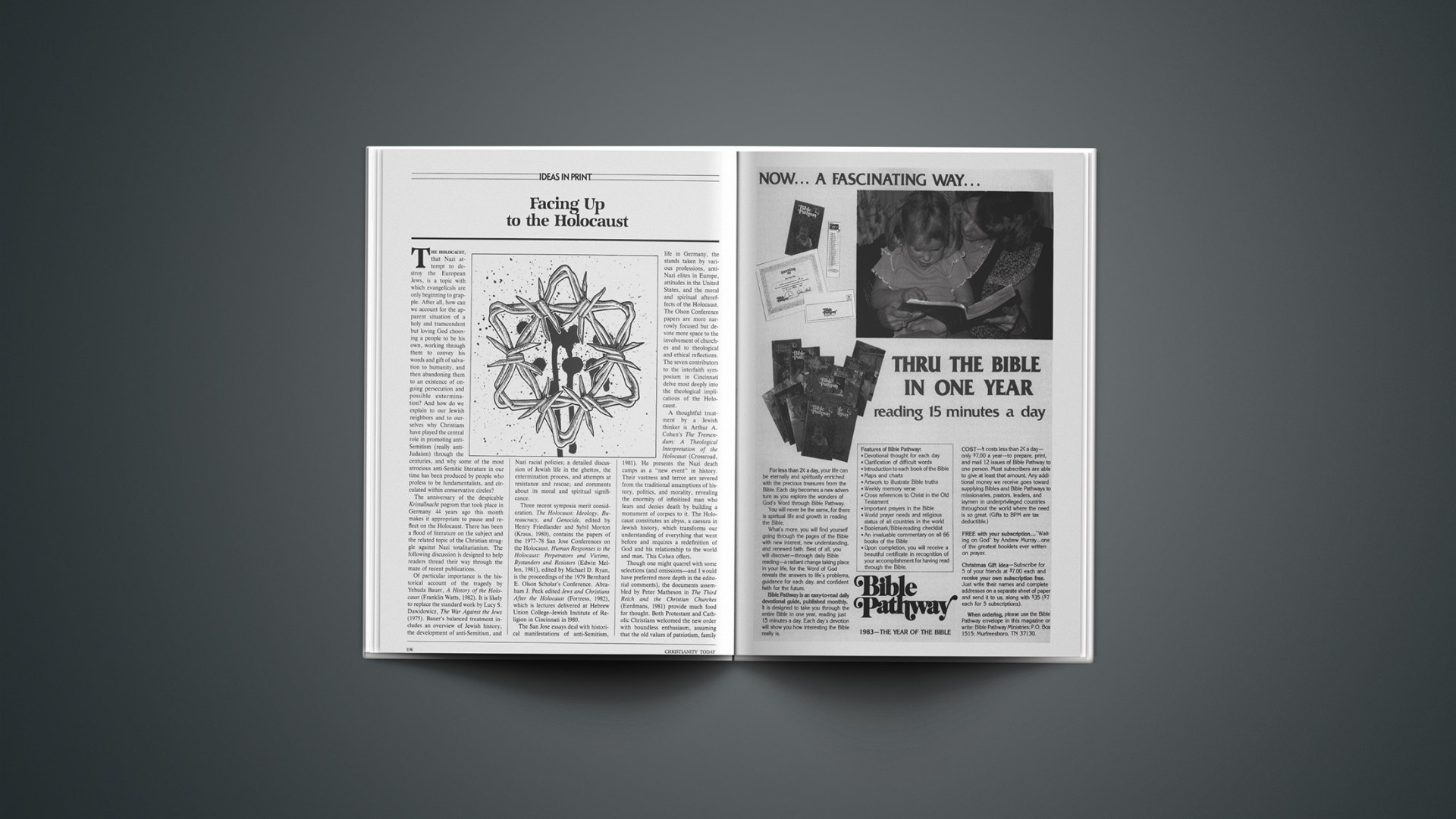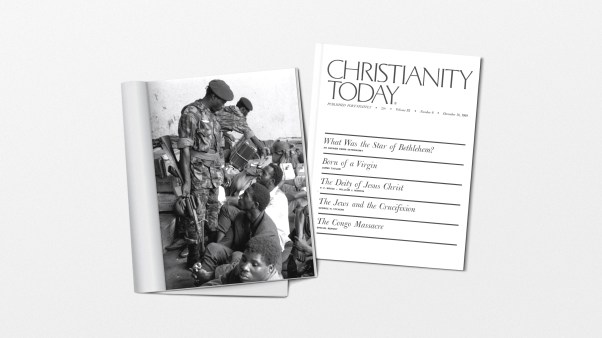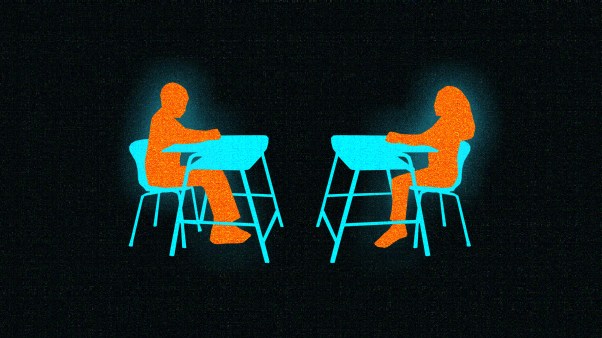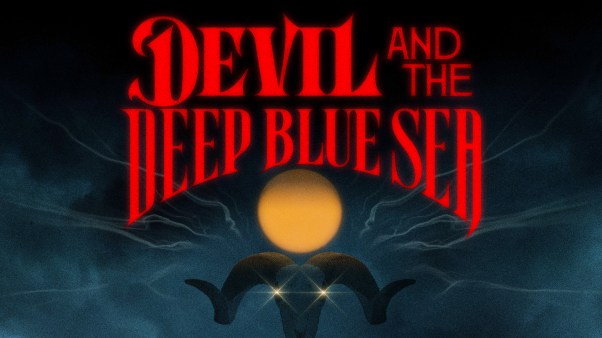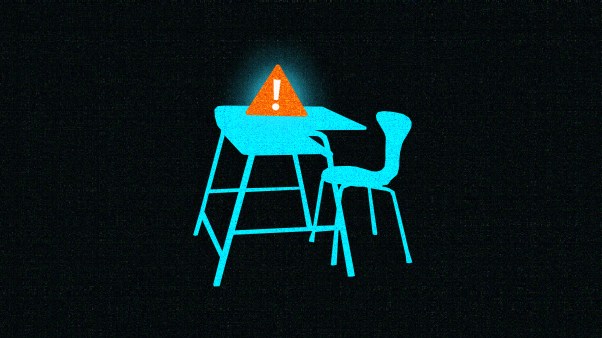Facing Up To The Holocaust
The holocaust, that Nazi attempt to destroy the European Jews, is a topic with which evangelicals are only beginning to grapple. After all, how can we account for the apparent situation of a holy and transcendent but loving God choosing a people to be his own, working through them to convey his words and gift of salvation to humanity, and then abandoning them to an existence of ongoing persecution and possible extermination? And how do we explain to our Jewish neighbors and to ourselves why Christians have played the central role in promoting anti-Semitism (really anti-Judaism) through the centuries, and why some of the most atrocious anti-Semitic literature in our time has been produced by people who profess to be fundamentalists, and circulated within conservative circles?
The anniversary of the despicable Kristallnacht pogrom that took place in Germany 44 years ago this month makes it appropriate to pause and reflect on the Holocaust. There has been a flood of literature on the subject and the related topic of the Christian struggle against Nazi totalitarianism. The following discussion is designed to help readers thread their way through the maze of recent publications.
Of particular importance is the historical account of the tragedy by Yehuda Bauer, A History of the Holocaust (Franklin Watts, 1982). It is likely to replace the standard work by Lucy S. Dawidowicz, The War Against the Jews (1975). Bauer’s balanced treatment includes an overview of Jewish history, the development of anti-Semitism, and Nazi racial policies; a detailed discussion of Jewish life in the ghettos, the extermination process, and attempts at resistance and rescue; and comments about its moral and spiritual significance.
Three recent symposia merit consideration. The Holocaust: Ideology, Bureaucracy, and Genocide, edited by Henry Friedlander and Sybil Morton (Kraus, 1980), contains the papers of the 1977–78 San Jose Conferences on the Holocaust. Human Responses to the Holocaust: Perpetrators and Victims, Bystanders and Resisters (Edwin Mellen, 1981), edited by Michael D. Ryan, is the proceedings of the 1979 Bernhard E. Olson Scholar’s Conference. Abraham J. Peck edited Jews and Christians After the Holocaust (Fortress, 1982), which is lectures delivered at Hebrew Union College-Jewish Institute of Religion in Cincinnati in 1980.
The San Jose essays deal with historical manifestations of anti-Semitism, life in Germany, the stands taken by various professions, anti-Nazi elites in Europe, attitudes in the United States, and the moral and spiritual aftereffects of the Holocaust. The Olson Conference papers are more narrowly focused but devote more space to the involvement of churches and to theological and ethical reflections. The seven contributors to the interfaith symposium in Cincinnati delve most deeply into the theological implications of the Holocaust.
A thoughtful treatment by a Jewish thinker is Arthur A. Cohen’s The Tremendum: A Theological Interpretation of the Holocaust (Crossroad, 1981). He presents the Nazi death camps as a “new event” in history. Their vastness and terror are severed from the traditional assumptions of history, politics, and morality, revealing the enormity of infinitized man who fears and denies death by building a monument of corpses to it. The Holocaust constitutes an abyss, a caesura in Jewish history, which transforms our understanding of everything that went before and requires a redefinition of God and his relationship to the world and man. This Cohen offers.
Though one might quarrel with some selections (and omissions—and I would have preferred more depth in the editorial comments), the documents assembled by Peter Matheson in The Third Reich and the Christian Churches (Eerdmans, 1981) provide much food for thought. Both Protestant and Catholic Christians welcomed the new order with boundless enthusiasm, assuming that the old values of patriotism, family life, and respect for authority would be restored and the red tide of Bolshevism turned back. But as these 68 church-struggle documents show, the ecclesiastical leaders quickly found the ground cut out from under them by Hitler and national socialism.
Especially striking is the summary of a conversation that two Catholic prelates had with the Führer in April 1933. Hitler pointed out that he was only doing to the Jews what their churches had done for 1,500 years. Surely the chickens of Christian anti-Semitism were coming home to roost! But he also responded to a query about freedom for “confessional” schools (the equivalent of U.S. “parochial” or “Christian” schools) by saying “we need soldiers, believing soldiers.” Because these are the “most valuable” kind, his government would maintain the confessional schools in order to train “believing men.”
Although evangelical participation in Holocaust discussions is less noticeable, a start has been made. Modest evangelical-Jewish dialogues took place in 1975 and 1980; Bonhoeffer scholars Burton Nelson and Ruth Zerner are preparing studies of this towering figure; David Rausch has been writing in the Holocaust area; and the dissertations of Robert W. Ross, So It Was True: The American Protestant Press and the Nazi Persecution of the Jews (Minnesota, 1980), and William E. Nawyn’s American Protestantism’s Response to Germany’s Jews and Refugees (UMI Research Press, 1982) were published.
Jakob Jocz’s The Jewish People and Jesus Christ after Auschwitz (Baker, 1981), is a praiseworthy discussion of the differences between Christians and Jews concerning the role of God, Christology, Hebrew Christianity, Jewishness, mission, and dialogue. It is based on a thorough knowledge of Jewish literature, a sensitivity to Jewish feelings and insights, and a willingness to hold firmly to the central tenets of Christianity.
We will probably never fully understand the Holocaust, but these books are groping in the right direction. Ultimately, we are cast upon the mystery of God in eschatological faith that the Judge of all the earth will make it right, someday, somehow.
Reviewed by Richard V. Pierard, professor of history, Indiana State University, Terre Haute.
Judging English Bibles
The English Bible from KJV to NIV, by Jack P. Lewis (Baker, 1981, 408 pp., $16.95), is reviewed by D. A. Carson, associate professor of New Testament, Trinity Evangelical Divinity School, Deerfield, Illinois.
The cascade of new, English translations of the Bible has finally been reduced to a trickle. Most are still in print, making reliable introductions to the strengths and weaknesses of the most common ones of value to the church. Jack P. Lewis, professor of Bible at Harding Graduate School of Religion since 1954, provides just such a guide.
Lewis’s first two chapters survey the history of the Bible prior to the English versions, and the English versions prior to the King James Version. The third chapter focuses on “Doctrinal Problems in the King James Version,” and the remaining 11 chapters examine the strengths and weaknesses of the ASV, RSV, NEB, NASB, JB, NAB, NWT (Jehovah’s Witnesses), LB, TEV (the Good News Bible), NIV, and the New KJV. The book concludes with a 40-page bibliography: two pages on Bible history and translation and the rest a catalogue of most of the principal discussions of the versions treated in the book.
This work does not compete with more comprehensive one-volume histories of the Bible (such as F. F. Bruce’s The Books and the Parchments). It does go over almost the same ground covered by Sakae Kubo and Walter Specht in So Many Versions? Twentieth Century English Versions of the Bible (Zondervan, 1975), albeit in considerably more detail. (Kubo/Specht discuss 15 English-language Bibles in 240 pages; Lewis treats 12 in 400 pages). The stance, theological and linguistic, is as careful and “neutral” as could reasonably be expected. Lewis tries to be even-handed, and the plethora of examples he cites insures that disagreement with him on some detail rarely jeopardizes his larger case. Nowhere does he selfconsciously formulate the criteria by which he assesses “good” and “bad” in translation (unlike, for instance, the work of Eugene H. Glassman, The Translation Debate: What Makes a Bible Translation Good? [IVP, 1981]). But his practice of assessment reveals Lewis as a sympathetic and sensitive supporter of “dynamic equivalence.” Lewis does not come out unequivocally in favor of any one translation. But he insists that although he is hard on some of them, God’s Word can be heard in any translation if it is read prayerfully. He tellingly draws a comparison between English versions of the Bible and dictionaries, for, as Samuel Johnson once said, “Dictionaries are like watches; the worst is better than none, and the best cannot be expected to go quite true.” This is an admirable book, one that quietly masks long hours of careful study behind readable prose and mature judgments.
The Preached Word
Thru the Bible, Vol. 1, by J. Vernon McGee (Nelson, 1981,612 pp., $22.50), is reviewed by Paige Patterson, president of the Criswell Center for Biblical Studies, Dallas, Texas.
J. vernon mcgee’s 21 years as pastor of the Church of the Open Door in Los Angeles, followed by a burgeoning radio ministry, well established in his mind that regardless of the proliferation of preaching, there is “a famine in the land for the Word of God.” As a result, he devoted over half a decade to a series of radio messages that began in Genesis and culminated in the Apocalypse. This volume is the first of a projected five encompassing those expositions. McGee’s preface charts the course for his work, stressing that he is making no attempt to present “a theological or technical commentary on the Bible.” He is a “popularizer.”
The introduction concerns the nature of the Bible and gives guidelines for successfully grasping the message of Scripture. McGee stresses his confidence in the Bible, insisting that “the words of Scripture are inspired—not just the thoughts, but the words.” Each book of the Pentateuch is discussed, using format of introduction, outline, and exposition. The introductions are adequate, the outlines superb, but the expositions are a mixed bag.
This critique of the expositions, however, is not an assault on content but a frustration with their brevity. A theologian, pastor, or other serious Bible student reading this will harbor the suspicion that McGee knew a great deal more than he told. Furthermore, Deuteronomy is slighted in space allotment, which seems unfortunate in light of the way Deuteronomy lends itself to the work of the preacher. There are also some unfortunate and inaccurate observations. For example, McGee predicts that by the end of this century the theory of evolution will be “as dead as a dodo bird.” Could we be so fortunate? The theory may appear in a change of dress by then, but not in its posture.
McGee is a “gap theorist” in interpreting Genesis. Creation occurred in six 24-hour periods following the initial upheaval of the primitive earth. He dismisses the possibility that “the sons of God” in Genesis 6 refers to angels. The full historicity of the Pentateuchal narratives is affirmed, and the Mosaic authorship of the whole is assumed. In general, the volume is representative of conservative evangelical opinion with few intrusions of novel or odd interpretations.
The strengths of this treatment of the Torah are principally three. First, for the man with only limited reading time, McGee’s interpretation is a marvel of succinctness and lucidity. Second, this clarity is accentuated by the author’s knack for cogent illustration. With his multifaceted examples, allusions, and picturesque phraseology, McGee’s appealing individualism adds a unique fragrance to the exposition. For example, he advises students to be honest about using the materials of others, counseling that, “You ought to graze on everybody’s pasture, but give your own milk.”
But McGee’s greatest contribution is his demonstration that the Bible is not only understandable but also teachable and preachable. This is true of even such delicate subjects as Zipporah’s circumcision of Gershom (Exod. 4) and the laws concerning unclean bodily discharges (Lev. 15).
The layman will revel in this book, while the pastor and the theologian will find its homey presentation refreshing.
God In Irian Java
The Night the Giant Rolled Over, by Jerry Jenkins (Word, 1981, 160 pp., $7.95), andThe People Time Forgot, by Alice Gibbons (Moody, 1981,324 pp., $5.95), are reviewed by Larry M. Lake, English department chairman at Delaware County Christian School, Pennsylvania.
These two books document the impact of Christian missions on people in Irian Jaya (formerly Dutch New Guinea) from strikingly different perspectives. The Night the Giant Rolled Over describes the role of missionaries and Mission Aviation Fellowship in relief and rebuilding efforts following a major earthquake in 1977. It illustrates the importance of small aircraft in primitive conditions, and portrays the vulnerability and courage of several missionaries, most notably Jerry Reeder and Jeff Heritage, both MAF pilots. Parts of this book suffer from generalizations and a too-broad overview of a complex area. Although Jenkins’s visit to Indonesia was unfortunately brief, he has done his homework; eyewitness accounts of the earthquake and of relief work are detailed and captivating.
The People Time Forgot is the result of a different perspective. Don and Alice Gibbons and their family lived for nearly 25 years with the Damal people of central Irian Jaya. The book sometimes provides an overabundance of detail (place names, intricacies of ritual, meticulous recounting of events), and a tendency to measure the relatively slow growth of the church in other areas by the phenomenal development of the church in the Ilaga and Beoga. But such subjectivity results in an engaging and personal view of the great, often beneficial, changes Christianity has brought to this formerly neglected people.
The book describes Damal life and culture before the missionaries appeared on the scene by recounting the life stories of several Damals who later became Christians, in the style of Richardson’s Lords of the Earth (Regal, 1977). Part 2 describes the efforts missionaries made to reach the Damal, and the Damal’s own myths about the “immortals” with light skin who would someday return to tell people how to live forever. The last section describes church growth, the innovative literacy program in the Beoga valley, and the evangelistic missions Damal Christians are now undertaking in other parts of Irian Jaya, Indonesia. All in all, the reading is good and it offers a rare look at a remote place where God is also at work.

